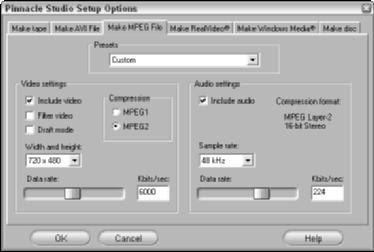
Digital video contains a lot of data. If you were to copy uncompressed digital video onto your hard disk, it would consume 20 MB (megabytes) for every second of video. Simple arithmetic tells us that one minute of uncompressed video would use over 1GB. Even with a 60GB hard drive, you would have room for only about 50 minutes of uncompressed video, assuming that big drive was empty to begin with. Dire though this may seem, storage isn’t even the biggest problem with uncompressed video. Typical hard drive busses and other components in your computer simply can’t handle a transfer rate of 20MB per second, meaning that some video frames will be dropped from the video.
To deal with the massive bandwidth requirements of video, digital video is compressed using compression schemes called codecs (compressor/decompressor). The DV codec, which is used by most digital camcorders, compresses video down to 3.6MB per second. This data rate is far more manageable than uncompressed video, and most modern computer hardware can handle it without trouble. When you capture DV video from a camcorder using a FireWire interface, a minute of video consumes just over 200MB of hard disk space. Again, most modern computers can manage that. Why do codecs matter to you? When you choose a file format for exporting your movie, you’re also usually choosing a codec to compress your movie (whether you realize it or not). Usually your export software automatically chooses a codec for you, but as you’ve seen in this chapter, you can also usually choose a specific codec if you wish. Some codecs compress video more than others. Generally speaking, the more video is compressed, the more quality you lose. In most cases I recommend you use the default codec chosen by Studio (or whatever program you are using) when you select an export format.




























